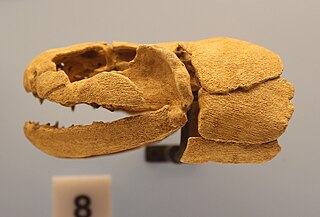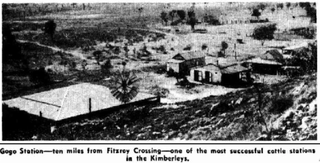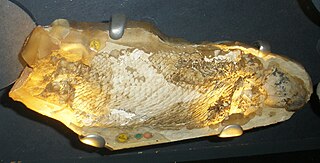
Dipnorhynchus is an extinct genus of marine lungfish from the middle Devonian period (Emsian) of Australia.

Gogonasus was a lobe-finned fish known from three-dimensionally preserved 380-million-year-old fossils found from the Gogo Formation in Western Australia. It lived in the Late Devonian period, on what was once a 1,400-kilometre-long coral reef off the Kimberley coast surrounding north-western Australia. Gogonasus was a small fish reaching 30 to 40 centimetres in length.
Diabolepis is an extinct genus of very primitive marine lungfish which lived during in the Early Devonian period. It contains a single species, D. speratus of Yunnan, China, from the mid-late Lochkovian of the Xitun Formation. It is one of the oldest known lungfish genera. It is the only member of the family Diabolepididae and the order Diabolepidiformes, although neither of these parent taxa have been officially described, despite their names being in scientific usage.

Onychodus is a genus of prehistoric lobe-finned fish which lived during the Devonian Period. It is one of the best known of the group of onychodontiform fishes. Scattered fossil teeth of Onychodus were first described from Ohio in 1857 by John Strong Newberry. Other species were found in Australia, England, Norway and Germany showing that it had a widespread range.

The Gogo Formation in the Kimberley region of Western Australia is a Lagerstätte that exhibits exceptional preservation of a Devonian reef community. The formation is named after Gogo Station, a cattle station where outcrops appear and fossils are often collected from, as is nearby Fossil Downs Station.
The Xitun Formation is a palaeontological formation which is named after Xitun village in Qujing, a location in South China. This formation includes many remains of fossilized fish and plants of the Early Devonian period. It was originally referred to as the Xitun Member of the Cuifengshan Formation.
Ferganoceratodus is a genus of prehistoric lungfish known from the Mesozoic of Asia and Africa. Based on morphological evidence, it has either been recovered as a basal member of the Ceratodontiformes or to be the sister group of the Neoceratodontidae.

Chirodipterus is an extinct genus of marine lungfish which lived during the Devonian period. Fossils have been found worldwide, including Germany, China, eastern & western Australia, and the United States (Michigan). However, it has been suggested that the genus as currently defined is polyphyletic, in which case only the German type species would belong to the genus.
Melanognathus is a genus of prehistoric lungfish which lived during the Devonian period.

Gnathorhiza is an extinct genus of prehistoric lobe-finned fish (lungfish) which lived from the Carboniferous period to the Early Triassic epoch. It is the only known lungfish genus to have crossed the Permo-Triassic boundary. Several species have been described, ranging in size from 5 to 50 centimeters.
Ichnomylax is an extinct genus of lungfish which lived during the Devonian period. Fossils have been found in Australia and Russia.
Gogodipterus is an extinct genus of prehistoric marine lungfish in the family Chirodipteridae. It contains a single species, G. paddyensis, known from the Late Devonian Gogo Formation of Western Australia. It was formerly placed in Chirodipterus.
Devonosteus is an extinct genus of prehistoric marine lobe-finned fish known from the Late Devonian. It contains a single species, D. proteus from the late Frasnian of Wildungen, Germany. It has sometimes been considered a lungfish of the family Holodontidae, but this remains uncertain as the original specimen may be lost. Alternatively, it may be a tristichopterid, a type of basal tetrapodomorph.
Mioceratodus is an extinct genus of lungfish in the family Neoceratodontidae, which also contains the extant Queensland lungfish. It is known only from Oligocene and Miocene-aged sediments in Australia, although phylogenetic evidence supports it having first diverged from its closest relative, Neoceratodus, during the Late Jurassic or Early Cretaceous period.
Rhinodipterus is an extinct genus of prehistoric dipnoan sarcopterygians or lobe-finned fish, that lived in the Devonian Period, between 416 and 359 million years ago. It is believed to have inhabited shallow, salt-water reefs, and is one of the earliest known examples of marine lungfish. Research based on an exceptionally well-preserved specimen from the Gogo Formation of Australia has shown that Rhinodipterus has cranial ribs attached to its braincase and was probably adapted for air-breathing to some degree as living lungfish are. This could be the only case known for a marine lungfish with air-breathing adaptations.

Ptychoceratodus is an extinct genus of lungfish living from Early Triassic to Middle Jurassic. It was established by Otto Jaekel for one species, transferred from Ceratodus genus. Type species is P. serratus from the Middle Triassic of Switzerland and Germany. Ptychoceratodus had two pairs of massive dental plates, bearing 4-6 acute ridges. Its skull roof was composed from massive, plate-like bones. In the central part of skull roof was localized an unossified fenestra. Most of the Ptychoceratodus findings are isolated dental plates, some associated with jaws. Other parts of skull or postcranial skeleton are relatively rarely found as fossils. The anatomy of skull is the best recognized in P. serratus, whereas less complete cranial material is available also for P. concinuus, P. phillipsi, and P. rectangulus. Although Ptychoceratodus is known exclusively from the Triassic and Jurassic, there were also Cretaceous specimens referred to this genus. However, they are more often regarded as representants of Metaceratodus. Ptychoceratodus is the only member of the family Ptychoceratodontidae. The first named species is P. phillipsi by Louis Agassiz in 1837 as a species of Ceratodus and later moved to the genus Ptychoceratodus. Occurrences of Ptychoceratodus come mainly from Europe. However, occurrences from other continents suggest it was dispersed globally during the Triassic. After 2010, the new fossil material behind the Europe was reported from South America, India, and Greenland
Tarachomylax is an extinct genus of prehistoric sarcopterygians or lobe-finned fish.
Griphognathus whitei is an extinct species of lungfish from the late Devonian period of Europe and Australia.
Holodipterus gogoensis is an extinct species of lungfish from the late Devonian period of Europe and Australia.








